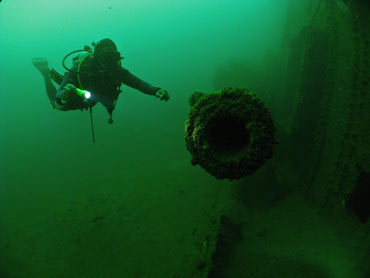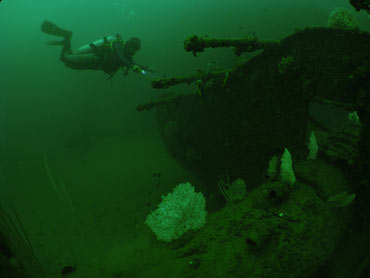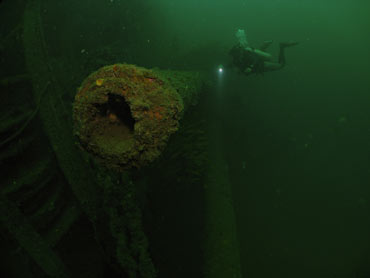
choose an article
|
||
The Americans left Subic Bay in November 1992, with their tails ever so slightly between their legs. The lease on their naval base had expired, negotiations for an extension had broken down, and the Philippines wanted them gone. With their air base up the road at Clark now lying under volcanic ash fall of biblical proportions, post- Pinatubo, the flesh pots and go-go bars of Fields Avenue subsequently deserted, there was little reason for them to stay. So they sailed away, to more congenial outposts in the Pacific, leaving behind a lot of empty buildings, telegraph poles, and an economic vacuum in their wake. For Australian Brian Homan, their departure presented the opportunity he’d been waiting for. There was nothing pretentious or flash about Brian; it was all understated class, so he entered Subic under full sail. At the helm of a replica 16th Century Spanish galleon, as any self respecting pirate would. The galleon fell into his hands after it arrived on his doorstep at Puerto Galera, Mindoro, ‘The Port of Galleons’ on ‘The Isle of Gold.’ Her intrepid crew had been at sea for months, following ancient trade routes, and now, naturally keen to return to their wives and girlfriends, decided air travel was the future. They just needed someone to mind their galleon ‘for a while’, and that they’d ‘come back and get it.’ Of course, they never did. Which is how the Pirate King of Subic Bay arrived in such befitting style. The local paper had a field day. Brian’s first task was to recce the abandoned base, and take a saw to all the redundant telegraph poles. “Anything to save a buck in those days”. With his newly acquired timber Brian built Vasco’s, his resort and museum, on the site of an old coaling station, which lies at Magellan’s Landing off the Argonaut Highway. But the lumber was just booty. Brian was in Subic for plunder. An armoured treasure chest, weighing 8,200 tones, 110m long, stuck in the ooze, 30m down. Something the Americans had discarded the last time they left Subic in hurry, back in 1941... Most shuttles services from Angeles and Manila will drop you off at the door. The initial impression is of a pirate fort, with ramparts, canon, and a parrot, and it’s a theme continued through the open bar and restaurant overlooking the water, perfect for a sun downer. Take a closer look and it soon becomes apparent that there’s genuine antiquities scattered amongst the pirate paraphernalia; sunken porcelain in the aquarium is the real deal. Rooms are galleon cabin style, complete with television, en suite, a bed to die for, and a stack of scuba diving magazines to whet your appetite. The kitchen runs 24/7, handy for a midnight snack, or breakfast en route to the dive shop and jetty next door.
Born in Newcastle, New South Wales, in 1952, the Year of the Dragon, he was thrown out of the Catholic school after he beat a Brother with a cane for making improper advances. Looking back, Brian considers his expulsion a blessing in disguise. “If I hadn’t got out of there, I’d have ended up a gay banker.” His early love affair with motorcycles led to an impressive array of fines, and when the law caught up, a spell in juvenile remand, the deterrent of Long Bay, the biggest and toughest prison in NSW, visible through the bars. Leaving Australia, he arrived in Puerto Galera in 1979, and saw the Muelle Cross, the canon-flanked monument commemorating the sinking of the battleship ‘Canonero Mariveles’ a century before. Setting up ‘Capt’n Gregg’s’ dive shop on Sabang Beach, Brian started to search for the Mariveles in his spare time.
Four years later on a drift dive, he saw a circle on the seabed, and carefully shooing away the sand, exposed a snarling temple dog. He’d found a sixteenth century Ming Dynasty dragon jar. It turned out to be one of over two dozen jars, that traced the outline of a vessel, buried at 22m. Brian headed to the heart of old Manila in jeans and a pair of sensible shoes he’d bought for the occasion. The shoes, he tells me, “were killing him”. He arrived at the National Museum of the Filipino People for an appointment with curator, Jesus ‘Jesse’ Peralta. According to Brian, the conversation with Jesus went something like this; “I’ve recovered these pieces from a shipwreck I’ve found in Puerto Galera.” “You don’t have a permit to do that.” “I was looking for lobster, and I found a shipwreck.” He showed Peralta a pale translucent dish, 600mm in diameter and a blue and white porcelain wine flask. They made plans for a scientific recovery of the site. There were three main considerations;
They drew up a contract. Brian raised everything. The museum had first claim on every type of item recovered, and they split the remainder 50:50. Although the museum provided divers, they were only ever trained in theory - they’d never actually recovered a site. Brian became a self-taught underwater archaeologist and the coast guard provided the security. Most of the storage jars were intact. Many items were buried in sand, so were recovered in pristine condition. They found ceramics, cooking utensils, personal effects and part of the ship itself. The vessel was identified as a Filipino ‘Balanghai’, a 15m outrigger sailing boat with a relatively sophisticated hull design. The team employed suction pipes to hoover away some six centuries of sand and sediment; that’s how long the wreck had laid undisturbed, established by carbon dating the artefacts. The wood was South East Asian teak, charred, indicating fire, but whether accidental, or piracy, no one knows.
What the wreck proved was that there had been international trading between the Mindorans and the Chinese, as early as the fifteenth century. The Chinese unloaded silks, metal goods, jars of delicacies and wine. In return they took spices, herbs, beeswax, coral and gold. The Philippines consists of some seven thousand plus islands that sprawl across the Asian trade routes; a crossroads of international maritime traffic, with Chinese junks and Arab dhow traders, clippers of the British East India Company, the Spanish and Portuguese searching for the spice islands, harried by Dutch freebooters and English privateers. Not to mention the respective fleets from two world wars. Wrecks were created by typhoons, uncharted reefs, warfare and piracy. Brian became a regular Government contractor for wreck expeditions. Occasionally they took the army with them for their protection. Other recoveries were more traumatic. On 2nd July 1993, a floating pagoda, part of a religious festival on the Bocaue river in Bulacan, capsized when fireworks sent the crowd careering across the deck. Two hundred and forty seven people died. |
published in Sport Diving Magazine
“Vis was like this”, he says, shaking a soy sauce bottle on the condiment tray. “You’d just feel your way along the riverbed, trying to find a wrist or an ankle. When I came up one time I realised I’d got two kids locked in embrace ... We used to have Scotch in between dives. That sort of thing will mess you up for a year.” He didn’t say ‘mess’. You can’t begin to imagine the rest. Who would want to. To lighten the mood, Brian digs out a video made in the mid 1980’s, when he dived the WWII wrecks of the Irako and Akitsushima, part of the sunken Japanese merchant fleet at Coron, at the northern end of the spine of Palawan. Numerous artefacts from Brian’s adventures reside in the display cases of his fascinating museum, chronicling his explorations, including a Buddha statuette he recovered from an officer’s cabin on the Akitsushima. These excavations were carried out before the authorities put a stop to the trophy hunting, and before Brian’s wife knew the team had recruited a couple of very attractive bar girls to help with the daily chores onboard. Nowadays Brian is happily married to wife number two, and tends to puts things back. His latest project is making replica canon, which are set in shallow water to form an artificial reef. These counterfeits are already attracting barnacles and oysters after only a few months. He theorises that if you’re going to build an artificial reef, you might as well use something that’s in keeping, rather than just chucking in a shopping trolley, as they do round my way. Hopefully divers in the future will appreciate Brian’s construction for what it is. “They’ll probably think they’ve discovered a new wreck, when in fact it’s just one of my crab apartments.”
With all the stories it’s easy to forget I’ve come to Subic to dive a major wreck. The USS New York lies on her port side in the bay at Caiman Shoal in 29m of green water, just a click from Vasco’s dive shop. The water is clean for the nine o’ clock dive, with easily 10m visibility, better than I’d dared to hope for. It will decrease to about 6-7m for the mid day dive, but still workable for photographers. Initially it’s slightly chilly in a 3mm wet suit, but the excitement will take care of that. I come off the line at the stern with Filipino guide Jason, on to the upturned starboard side at 15m. When Brian first arrived, this exposed hull was covered in a blanket of ash, up to 15cm thick, fallout from the Mt. Pinatubo eruption.
This has now been cleared away, presenting divers with a beautiful vintage battle cruiser, once the pride of the US fleet in Asia, and simply the best wreck dive The Philippines has to offer. I don’t know who to thank. The Americans for scuttling her in ‘41, or the Japanese for advancing and giving the Americans the jitters in the first place. Or the Filipinos for not renewing the US lease, or Brian for cleaning it. Or the Americans for not being in port today, because you can’t dive the wreck when they’re passing through. Commissioned in 1893, this US Navy armoured cruiser was later renamed the Saratoga, then Rochester. When her three funnels were belching she could make 21 knots. She saw action during the Spanish-American war, was active in relief, transport, escort and general troubleshooting. Decommissioned in 1932, she was stripped of fittings and lay at anchor in the Olongapo shipyard before the US scuttled her in December 1941, to prevent her falling into enemy hands.
The prop shaft runs some 8m off the stern, and there, just as Jason promised, is the ‘Mickey Mouse’ propeller, so called because of the distinctive silhouette. A nice sponge has taken up residence between the gigantic ‘ears’. We move off on a loop tour of the wreck, now finning over the seabed with the deck as a right hand ‘wall’. The golden muzzle of the 200mm stern gun, originally one of a pair, stretches out from the emerald fog. I spoil the moment by telling Jason just how ‘Big!’ and ‘Wow!’ it is, because it’s the first time I’ve seen it, and even though he’s seen it all before, to his great credit, he humours me. Advanced wreck divers can make the engine room on a set of twin tanks, and the boiler room can be reached on a single. Please note the very visible memorial plaque to the diver who didn’t make it out alive. As we arrive mid ships, the mast comes into focus. Although stuck in the mud on the bottom, this is beautiful, with a conning tower-cum-crow’s nest affair, tapered to a fin, almost Art Deco styling, There’s plenty of soft coral growth dotted around, but they don’t detract from the rungs and rivets. And so to the twin bow guns. A pair of 200mm monsters that bend in the frame of a fisheye lens. Sunken and skewed, they’re still the most imposing feature on the wreck and I find it difficult to drag myself away. We’re strafed by a pair of eagle rays, gliding over the wreck in tandem as we move towards the ornate forecastle, shaped like a fleur de lys, for anchors at either side. There’s also a hawse pipe in the prow for a third anchor to be dropped, and the prow itself is angled away from the deck, sloping towards the waterline. perfect for ramming. As we traverse the bow, we’re ascending to avoid deco. Jason and I both have about a minute, thanks to mast and big gun mania, so we’d better get a move on. There are several gun ports visible on the sunlit starboard side, the ship had a dozen in total, but these 100mm single canons have been removed. To compensate for this, there are several portholes, glass still intact, that actually move in their frames, and a soft coral and hydroid garden, reminiscent of a tendered allotment, as we come back to the line to make our ascent. We’re back on the dock before our computers have even had time to check out. Brilliant. Why did no one ever rave about this wreck? Why is Subic almost regarded as an after thought by the Filipino tourist board? This is my third trip to The Philippines and if I’d have known then what I know now, Subic and the USS New York would have been at the top of my ‘To Do’ list. “They didn’t market it properly”, says Brian.
He takes me on a tour of the former base. The Naval housing estates, now sold off, retain a touch of The Atomic Cafe. A gated community of expansive dwellings, green lawns and manicured shrubbery, with an international school for expat kids. Suburban utopia, and yet seemingly no one home. There’s horse riding, a whale show, a tiger safari, a bat encounter, tree top adventure world, jungle hikes, bush craft school, and kayaking along several beautiful rivers. If that lot and the wrecks hasn’t worn you out, there’s a few conspiracy theorists on the barstools at Vasco’s in the evening, or you can take a short cab ride to the bright lights and loud music at the Lighthouse Marina resort. Brian sees me off. I want to give him a hug, because it’s been emotional, but he’s a pirate, the self proclaimed ‘Homan The Horrible’, so he doesn’t do hugs. He just tells me to come back sometime, because - “You haven’t heard the half of it”.
The Bay of Wrecks Although Subic diving is naturally dominated by the wreck of the USS New York, the bay is a time capsule, with most wrecks close to shore and within recreational depths. The 130m freighter El Capitan, sits on the bottom at 25m in Ilanin Bay, an inlet on Subic’s southern side. The wreck hosts good marine life with generally good visibility and easy penetration. The San Quentin was scuttled by the Spanish in the mouth of the bay to obstruct the American advance in 1898. It’s now pretty much a debris field at 16m, although the boilers protrude. Again this site has proliferation of marine life and currents promise good vis. Seldom dived, the Oryoku Maru has the bloodiest history of all the wrecks in Subic. Originally a passenger liner, she was used as a Hell Ship during WWII for Allied POWs. Unmarked, she was sunk by a US air strike. It was later discovered there’d been some 1600 prisoners aboard. Post war the wreck lying at 20m was flattened as it impeded a major shipping lane. There is also a LST landing craft. This lies at some 40m, and although its weaponry looks like a peashooter in comparison to the massive canons of the New York - hey - they’re still guns. Expats rate this dive. Tantalisingly, Brian Homan believes there are still many additional wrecks still waiting to be discovered. For bookings and further information, contact
|
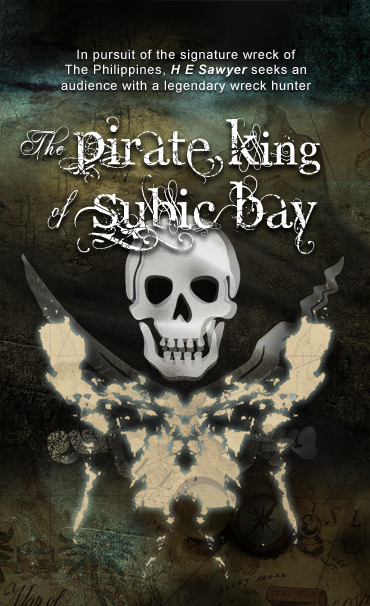
 Brian Homan is immaculate, not a single sliver hair out of place. Behind sharp eyes he possesses the uncanny knack of sizing you up without you realising what he’s doing, until he’s done and satisfied. Only then will the stories begin to unfold. To say his life has been colourful would be an understatement.
Brian Homan is immaculate, not a single sliver hair out of place. Behind sharp eyes he possesses the uncanny knack of sizing you up without you realising what he’s doing, until he’s done and satisfied. Only then will the stories begin to unfold. To say his life has been colourful would be an understatement. 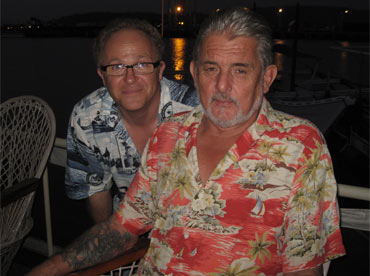
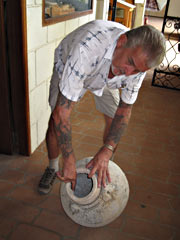 Firstly to protect the site from looting. Secondly, to plan a systematic recovery programme, so anything of anthropological or archaeological interest was not destroyed, and lastly, to be able to finance the project.
Firstly to protect the site from looting. Secondly, to plan a systematic recovery programme, so anything of anthropological or archaeological interest was not destroyed, and lastly, to be able to finance the project.
